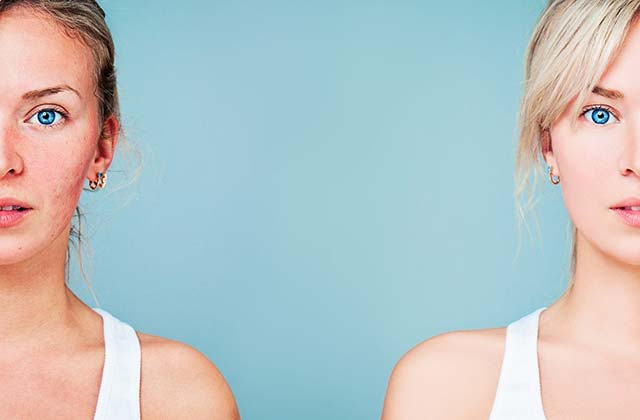What is Rosacea?
Rosacea starts out as mild and occasional redness in the face that can look like a blush or light sunburn. Initially the redness might come and go but over time the symptoms become constant and can advance from redness to visible veins, acne-like pimples to thick skin and watery eyes if not treated.
Who gets Rosacea?
Women under 30 and from Northern and Eastern European ancestry are most likely to get rosacea but it can affect men and women of all ages and ethnicities.
Although there is no known cure for rosacea at this time, the symptoms can be managed and reversed through a variety of lifestyle and medical treatments.
Self Care and Natural Rosacea Treatments
Here are some steps rosacea sufferes can take in their daily lives to lessen the frequency and severity of symptoms and outbreaks.
Daily Skin Care Regimen
When washing the face, use a mild, non-abrasive cleaner, then rinse with warm water and pat dry with a cotton towel. Do not rub or scrub the face with a washcloth or towel.
Basic Protections
Since many people with rosacea are fair skinned it makes sense to avoid direct sunlight as much as possible. And to apply sunscreen SPF 15 or higher and be sure to cover the entire face as well as ears, neck and chest. Also protect the face with a scarf in cold and windy weather to reduce skin irritation.
Some people have found that using bottled or filtered water to wash their face works better than tap water, perhaps because tap water contains chlorine.
Make Up and Rosacea
To cover existing redness common cosmetic colors are not a good solution because the red to brown colors in makeup actually bring out the underlying redness instead of covering it up. Pink and orange tints have the same problem. Instead try foundations with a green tint and yellow tones because they work well because to counter the rosacea caused redness.
Hypoallergenic Lotions and Cosmetics
Sensitive skin can react badly to chemicals found in some products. In general and especially during an outbreak try moisturizers, make up and cleansers that are noncomedogenic (don’t block pores), hypoallergenic and don’t irritate the skin.
Maintain a Food, Hygiene, Event Diary
Rosacea is a hard to classify disease and what works for one person may exacerbate it in another. It’s a good idea to keep a diary of food, medicine, menstrual cycle, and soaps or makeup used on regular basis.
This provides a reference to see the events taking place before, during and after a flare up to help determine what factors might be involved in making it worse or better. Also include external factors such as stress, travel, weather or time of year.
Dietary and Lifestyle Causes
Outbreak triggers vary from person to person but some have found relief from rosacea symptoms by avoiding drinking alcohol, not eating spicy foods. Other dietary changes people have tried is to avoid carbohydrates including wheat, gluten and sugar.
Stress has been reported as a trigger. Light exercise (but not heavy exertion) such as walking and relaxation activities like yoga, meditation or taking time out to read or sit quietly can help during stressful times.
Hormonal Triggers
Stress and hormones due to monthly periods, pregnancy or puberty have also been cited as possible triggers.
Leave Face Alone
Some patients reported good results by leaving the face alone as much as possible during a flare up. This method includes no soaps, gels or washing of the face, and no make up or sunscreen. The idea is to give the skin a chance to restore it’s natural balance with little or no outside interference.
Good Rosacea Resource
These are only a few of the broad categories of triggers; for a longer list and a food diary see the National Rosacea Society website at, http://www.rosacea.org/patients/materials/triggers.php.
Medical Treatments for Rosacea
While there is no cure for rosacea, symptoms, flare ups and long term damage can be reduced by a variety of medical treatment options.
People who think they might be suffering from rosacea should see a doctor for proper diagnoses and personalized treatment plan. The information here is of a general nature is not intended as a recommended treatment plan for anyone.
Antibiotics
Rosacea is not caused by a bacterial infection but antibiotics are one of the most recommended methods as an effective treatment to reduce symptoms. It’s the anti-inflammatory properties of some antibiotics that lead them to be used to treat rosacea on the surface of the skin.
Topical treatments to treat rosacea include azelaic acid, metronidazole and retinoids. Oral antibiotics might also be prescribed.
Acne treatments are not effective against rosacea even though later stages of the disease share some physical similarities. Topical acne treatments can make irritate the skin and make rosacea symptoms worse and definitely should not be used to try to control symptoms.
Light and Laser Therapy
Laser treatments are effective against general redness and visible blood vessels appearing under the skin. Another type of treatment using light treatments that is not a laser is Intense Pulsed Light (IPL) therapy. With IPL the light spectrum wavelength is adjusted to match the targeted area so that it goes through normal colored-skin harmlessly while effectively destroying the tissue causing redness.
Article Source: http://EzineArticles.com/6728762

